You are currently browsing the collecting category
Thelonious_Nick asked, in reference to Wednesday’s post
“How do you go about determining if these signature are authentic? Do you up the price for a signature? How much would you bump up Roy Thomas vs. Jack Kirby?”
Another reader, Chris V, gave his answer and I don’t think there’s anything there I’d disagree with. In this particular case, with this collection, my personal answer as to whether or not these autographs are real is “context.”
This was a largish collection, held by a private collector for many decades, kept in some pretty crummy plastic bags but were in consecutive order and very clearly part of an acquired run of books. It looked like a collection where someone bought each issue as it came out (or filled holes in their runs with back issue purchases), read ’em, bagged them up, then kept them in boxes. And that’s where they stayed until they were brought to me.
As such, finding the occasional issue with a signature inside very likely had that signature in it for many, many years. Could someone in the 1970s been going around forging signatures of comic book professionals? Sure, but it seemed like a pretty low-stakes crime for someone to have been pursuing. And nothing about these comics really seemed to make them stand out from the rest of the collection…they were just in there numerically with the other issues in whatever series from which the signed comic hailed. It just looks like a fan took a comic or two to a signing, had it signed, then dropped it back in the collection.
In short, it just feels like the signatures are authentic. Nothing about the collection or how the comics were kept make me suspect otherwise. I realize that when removed from this context, it may be harder to convince buyers of their authenticity, but I’m sure they’re exactly what they appear to be.
Like, I’m totally sure that’s Steve Ditko’s signature on this issue of Speedball. “Hang loose, and have a crazy summer!” it reads. Boy, if anything ever sounds like Ditko….
As for pricing them? Eh, maybe I’ll bump up the price half again, maybe twice. There’s no hard and fast rule on what to price these. Bigger the name, bigger the jump in cost, I guess? Just kinda winging it.
Okay, that’s it for 2021! Come back to my site in 2022 where I’ll ask the quesion “boy, remember how good we had it last year?” And speaking of next year, don’t forget to contribute to the 2022 comic industry predictions post! I’ll be starting to look back at the 2021 predictions in a week or so, so get ready for that!
Happy New Year, pals, and thanks for reading! Stay safe, and we’ll all meet back here on Monday!
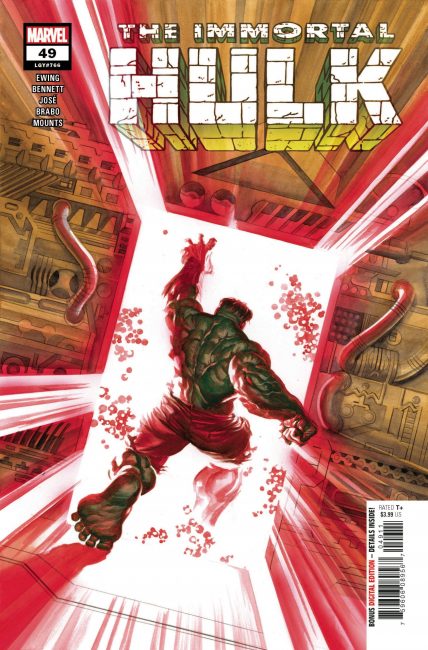
It’s a Special Album Issue, just like the good old days! Full-page illustrations combined with prose appearing in your otherwise regular Marvel funnybook…not a thing I’d like to see on a regular basis, but okay once in a while, especially if done well, like it is here, taking what could have been yet another Hulk-versus-heroes battle and applying some of the book’s usual levels of gravitas. One thing I liked is the opening (and continuing) comparisions between Bruce Banner and the Hulk with the Fantastic Four.
In an interesting confluence of events, Adam Warren, in his notes to Tuesday’s serialized page of Empowered, says
“…This does seem to represent a bit of a lost opportunity for superhero storytelling—that is, conveying how BLUDGEONING AND EARPIERCINGLY G-D LOUD that most cape-related conflict would be. Of course, the use of giant frickin’ sound FX and the like would burn up pagecount in a hurry, but this still seems like a narrative avenue worth exploring on occasion….”
And this issue of Immortal Hulk does just that, emphasizing the sounds of conflict, the drowned-out voices, et cetera…and given the illustrated text format of the issue, it manages to get around the sound effects problem that Warren posited. Thought that was a nice coincidence!
• • •
Joe
mentions, like I probably should have in Monday’s post, that the double-covered #2s had been a prominent feature during the “Heroes Reborn” year-long experiment with the Image Comics artists. Not just on the Reborn books, but on new title launches like
Thunderbolts (which I remembered) and he also mentions
Deadpool, which I didn’t remember and can’t find that it had a second cover (beyond having a newsstand “variant” with the standard UPC…am I missing something? Wouldn’t surprise me! ). Anyway, I should have noted when the two covers for the second issue started, and thank you Joe for stepping in.
Matthew asks
“Years ago I remember reading that for some period of time the second issue of the GI Joe series that Marvel put out was actually more valuable than the first issue because there were so many fewer issues printed. Was that ever true? Is it still true?”
Other commenters provided their answers, but I thought I’d answer here, too. Yes, there was a time when the second issue of Marvel’s G.I. Joe: A Real American Hero was commanding higher prices than the first.
Now I’m just working off my memories instead of, you know, doing research, but I believe the common belief was, true or not, that the second issue had a smaller print run that the first. And given that G.I. Joe was a relatively popular commodity at the time, it wouldn’t surprise me to find out that the first issue was in higher demand than expected, and retailers lowering the order on the second issue (without yet knowing how #1 would be received) resulted in the higher demand and comparative scarcity.
Contributing to this disparity in cover prices. Issue #1 was extra-sized and printed on nicer paper, selling at $1.50:
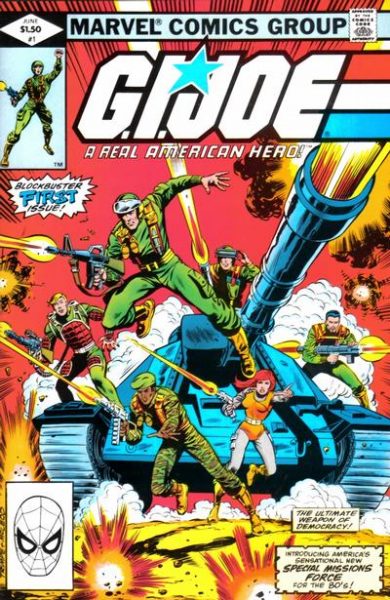
…and then #2 was the standard format comic at 60 cents:
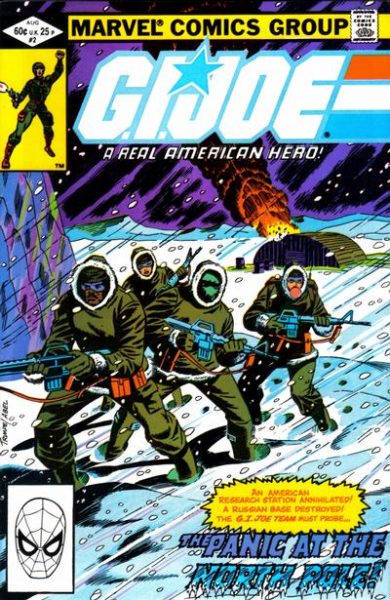
If I had to hazard a guess, backed up by literally no evidence whatsoever (though maybe I can peek through my fanzines from the period and see what sales on these were actually like) beyond my own proclivities as a comics retailer…I’d say that $1.50 price tag on a cartoon ‘n’ toy tie-in, two and half times the price of a standard comic, may have kept orders lower on the first issue. I mean, no matter how popular the property may have been at the time, there was no guarantee that would translate to comic sales of any note, and that high a price tag might have made the buying decision for anyone on the fence about it. And with that seeming barrier to entry, there was no reason to expect much repeat business for the second issue, even at the lower price.
Now please note that at no time am I saying the comic wouldn’t have had strong orders, or that it didn’t…just that the cover price may have kept them from being even stronger. And as it turned out, the first issue was very popular, enough so that there wasn’t enough of the second issue to go around, therefore low supply + high demand = $$$ for somebody. As a result, the price guide regularly had #2 listed at a higher price than #1.
But enough time has passed, with most early G.I. Joes being in less reliable availability at your local comics emporium, that the whole “lower print run” thing, if it ever actually was a thing, is of negligible importance in today’s market. #1 and #2 are both equally difficult to come across, and with the back issue market becoming increasingly focused on “number ones” and “key issues,” it’s not much of a surprise that prices for that first G.I. Joe have zipped on past those for the second.
So my former boss Ralph was at my shop this past weekend, helping me out with some things and stuff. I still had the Gouda Gazettes featuring in a post here last week, and being that it was from Ralph’s store I originally obtained these back in the ancient 1980s, I took the opportunity to ask him if he had any more details on these. I was wondering who these guys were, about how old they were, if they did more issues than this, that sort of thing.
Alas, Ralph didn’t even remember having these in his shop, so no more info was forthcoming. However, I did ask him if he remembered carrying another ‘zine at about the same time, and he did — 60 Miles North from 1983:
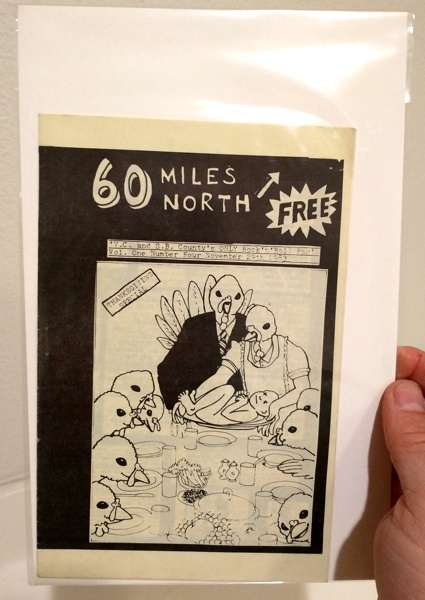
Now undoubtedly you see how it’s packaged here, which brings me to Keef’s comment from last week:
“What do you use for Zine storage? Modern boxes are too big. I found some weird boxes at Office Depot that work if you use ‘em sideways, but… I’ve always wanted something proper.”
As you see above, Keef, I just put ’em in a regular ol’ bag and board and then store them in a standard comic storage box. There are probably other storage solutions involving differently sized boxes, but I feel this is the simplest solution, using (usually) readily available supplies. I mean, I could bag ’em all up in paperback sleeves, or digest sleeves, and so on, but this way the storage box is uniform with others, and the comics inside are in mostly uniform protective packaging. Given the wide variety of sizes ‘zines like this can come in, putting them in bags and boards like this keeps the smaller ones from getting lost in the shuffle.
The Gouda Gazettes are a little wider, so I had to put those in Silver Age bags and boards:
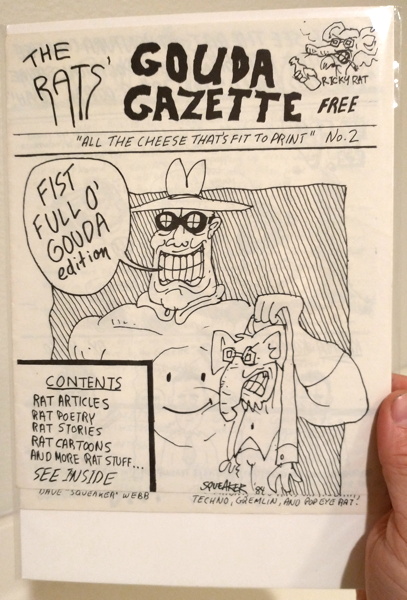
…but even still, bagged and boarded, it fits nicely in the box along the much smaller, but still in a standard bag/board, Things Not to Say to a Comic Shop Employee by a young cartoonist of some note:
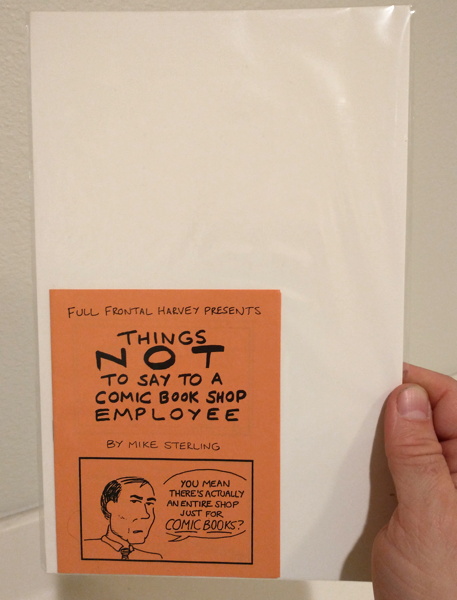
…which, by the way, you can read right here.
The smallest comics thingie in my collection is this mini, Baby! from my pal Fred, measuring about 2 1/4 by 2 1/4 inches:
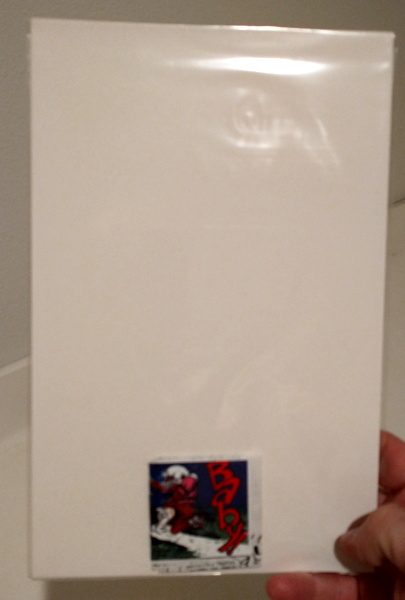
…but it folds open into a larger work. And the pic’s a bit blurry…sorry about that, but just as well as that cover’s a little naughty.
So Keef, I hope that helps. Rather than trying to find protective packaging and storage to fit the variously-sized mini-comics and ‘zines, it’s easier to make them fit into the boxes you’ve got. Easier to find the supplies you need, easier to keep them organized…because you never know when you’ll have to pull your copy of this comic out of your collection:
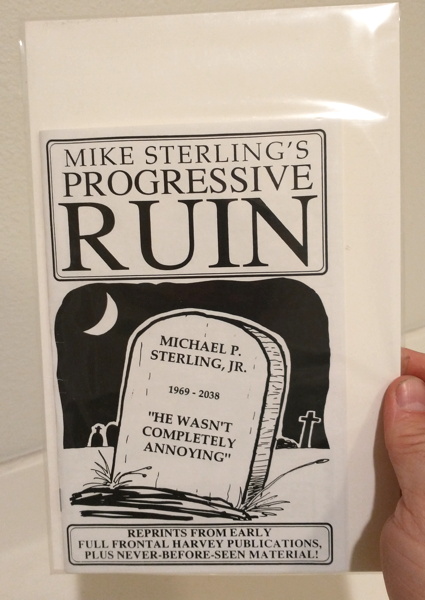
So I realize I’m probably expected to do a little something about the Swamp Thing anniversary this year (having debuted in House of Secrets #92 50 years ago as of about April). It’s also Man-Thing’s 50th, debuting in 1971’s Savage Tales #1, so overall it’s a good year for swamp monsters.
I expect I’ll get around to something eventually…or maybe this will the only acknowledgement. I honestly don’t know. I can’t say with all honesty “it’s been a great 50 years, here’s to 50 more!” because frankly things have kinda sorta fallen apart in regards to the Swamp Thing comics over the last ten years. Lemme ‘splain.
Well, actually, there’s not much ‘splaining to do. The New 52 relaunch sort of “broke the chain” of continuity between the Swamp Thing we had before and the later Swamp Thing. Part of the character’s appeal to me was its history, the sense that all of the events that happened to the character in its past have remained so, and continue to inform its future. Okay, granted, one or two things have been sorta kicked under the bed and not brought up again, but by and large I could (to use a phrase I’ve probably overused on this site) draw a line from the character’s 1970s comics all the way through to the end of Brightest Day. It was with the Brighest Day follow-up The Search for Swamp Thing and the New 52 relaunch that stuff went astray.
I won’t go into excruciating detail (again) but character elements were changed, Alec and Abby’s backstory changed, Arcane was an almost entirely different kind of creep, etc. Then with the advent of both creator Len Wein’s 2016 mini-series (which seemingly nullifies a significant part of the Alan Moore arc), and the digital-first stories where full-on Plant Elemental Swamp Thing is going up against…General Sunderland!? Well, that undoes another fairly significant part of Moore’s run. It literally plays havoc with the circumstances surrounding Swamp Thing’s evolution into the kind of character he is now.
Look, all the New 52 and later era work is fine on its own. Well, okay, not all, but most of it is perfectly serviceable. But for someone who’s followed the character for as long I have…not since the very beginning, but close…there’s a level of detachment. What I know of the character is not fitting with what they’re telling me about the character now, and it’s distracting. There are a number of stories that don’t require dependence on past continuity, of course, but once you remind me “Matt Cable is alive and he was never possessed by Arcane,” that throws me just a little. I feel…detached from what’s happening to the character.
Some of it is on me…given the vision troubles I’ve had over the last few years, I’m way behind on my comic reading. And some of the comics I haven’t read yet are Swamp Thing-related, such as the Walmart Giant issues (collected in a book that I have in place of said Giants, which I never found in the wild). My enthusiasm for the character having waned, I never made it a priority to catch up on those particular stories. I’m sure they’re perfectly good, but with everything else happening to Swamp Thing, I was in no rush to read more stories set in the same post-New 52 milieu.
Plus, on top of all that, there was my decision to not acquire every single appearance of the character, spurred on by this nonsense. I also stopped pulling both covers of Justice League Dark for myself if each had Swamp Thing on it. Being as behind as I am, the last thing I needed was more comic books floatin’ around the house. And besides, who am I trying to impress with A Complete Swamp Thing Comic Book Collection? It’s not like God won’t let me through the Pearly Gates when I die if I don’t have one. (Unless of course Wein and Wrightson are at his side, waiting for me, their arms crossed and shaking their heads in disappointment.)
Like I said in this post, I, The Guy What’s Read Swamp Thing Comics for the Last Several Decades, was not the target audience for these rejiggered relaunches. This rethinking of ol’ Swampy was designed to get newer readers ensnared, who likely hadn’t read all that early stuff.
Not to say everything is terrible, of course: Swamp Thing’s appearances in Justice League Dark gave me the month-to-month adventures that didn’t dwell a whole lot on his new backstory and almost felt “normal,” you know, more or less, guest-starring with Detective Chimp and everything. And the new mini, bringing in a new person as Swamp Thing with the Alec Holland Swampy primarily there to pass the torch…this may be the solution to finally getting past the character’s shattered history, and it helps that the comic is really good, too.
But anyway, in short, Swamp Thing is still my favorite comic character despite everything. I get that expecting editorial consistency on a comic book character in a shared universe in stories created by Many Diverse Hands is a bit of an ask. I mean, the Superman we got with the John Byrne reboot in 1986 is technically the same Superman we have now, though many of the details have changed over the decades. But I kind of expect that from superhero comics. I felt like Swamp Thing was different, like maybe folks were putting a little more effort into internal consistency over the years. That’s why just changing things for the sake of change (an endemic problem to the New 52 as a whole) was so disappointing.
• • •
On a related note, just recently we had a spate of “give me your controversial take on [comic character]” tweets on the Twitters (here’s
my favorite iteration and my response). So of course I jumped in with
“give me your controversial takes on Swamp Thing”. Got some good response, and some jokey ones, too, but c’mon, we’re all comedians on Twitter. But I plan on responding to some of those “takes” here in the near future.
Thanks for reading, pals, and keep in mind, despite all that stuff I said…I ain’t giving up my Swamp Thing slippers.
Jay from Tennessee volunteers the following
“What was it that you liked most about Firestorm?”
Let’s borrow Mr. Peabody’s WayBack Machine and travel back to the joyous, nigh-utopian days of 2007 when I wrote a bit about my Firestorm fandom:
Me: “You know what I like about Firestorm?”
Employee Aaron: “No, what?”
Me: “Well, Ron Raymond [Firestorm’s secret identity — well, one of them] is on the school’s basketball team, and he’s always getting picked on by the school brain, Cliff Carmichael. It’s some kind of weird parallel universe high school where the jocks get bullied by the smart guys.”
Aaron: “So what parallel Earth would that be?”
Me: “I’d call it ‘Earth-Remarkably-Improbable.’”
Okay, that’s a little facetious (what, on this blog? NOOOOO) but…you know, I was trying to think if I’d encountered Firestorm much prior to the launch of the 1982 series. I’ve read some Justice League of America before that, so I definitely c him there, and there were a handful of back-ups in Flash that I know I read. But at this point in time, I can’t recall if the character really grabbed my attention or if he just happened to be a dude in a comic I was reading for other reasons.
I suppose I must have liked him well enough to drop my two quarters and a dime on the first issue when it was released. I think a lot of it had to do with being an excited 11 to 13-year-old getting in on the ground floor of all these new comics that were popping up (like Saga of the Swamp Thing, natch, and All-Star Squadron, just to name a couple).
And like I said in my 2007 excerpt up there, I liked the weird premise of Firestorm actually being two people who would merge together into one shared-body superhero, with the impulsive teen (Ronnie) controlling the body and the older scientist (Martin) as the voice in his head. The additional twist of that “voice” being represented by Martin’s ghostly “head” that only we, the readers, and Ronnie could see was a clever one.
Another plus was the artwork, which remains my favorite example of Pat Broderick’s work to this day:
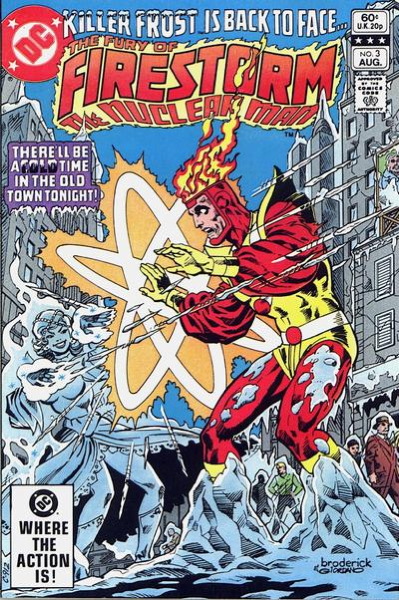
Even after doing this blog for nearly two decades I’m still not any better at describing art much beyond “pictures good,” but, hey, you know, pictures good. There was a detail, a graininess, to his work that felt…unusual to me at the time, which you didn’t see much in the usually much slicker superhero comics. Even when Broderick left regular penciling duties and was replaced by Rafael Kayanan:
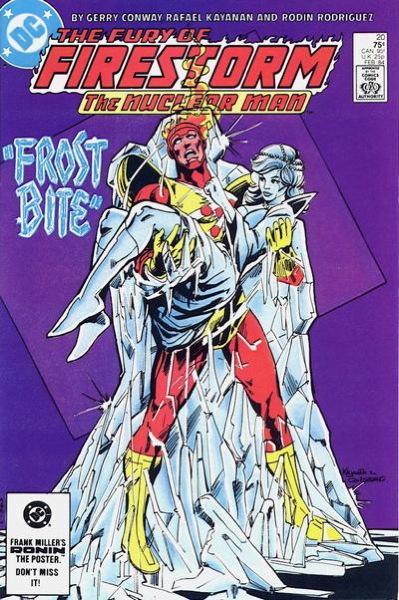
…the artwork was still somewhat Of A Kind with what had come before. A little slicker, maybe, but still evoked Broderick’s influence in a way that later artists on the title would leave behind.
I enjoyed the stories as well, particularly the difficulties superhero-ing placed on Ronnie and Martin’s personal lives (especially Martin, who initially didn’t retain memory of his time as half of Firestorm). And of course the whole business with Ronnie’s rivalry with Cliff Carmichael, as mentioned above. It was all presented with just the right mix of humor, melodrama, and action, and always felt like I got my money’s worth out of each issue. I realize in hindsight it’s all very Spider-Man, almost certainly intentionally, but for a kid who hadn’t read many of those Spideys, and certainly not from the beginning, this all seemed fresh and enthralling to me.
Okay, with all this “from the beginning” talk I should note that I was aware at the time there was a previous Firestorm series in the ’70s. Certainly that they named the title Fury of Firestorm to differentiate itself from the previous Firestorm I do remember noting back then (in the same way Saga of the Swamp Thing was so named as to avoid confusion with Swamp Thing.) This, amongst other quests, is what would eventually lead me to comic shops looking for back issues. I eventually got that first series, though oddly I never sought out the Flash back-ups I didn’t have. Ah well, I eventually bought the book, so that’s moot now.
Once or twice on this site I believe I’ve mentioned that I really enjoyed the beginning of Fury of Firestorm and the end of it, while kinda coasting along through the middle which wasn’t…well, let’s say it was a little more inconsistent. Not necessarily bad, but not always to my taste either. However, I was still invested in the characters and wanted to see what happened with them. Yes, even Cliff Carmichael.
This is, unsurprisingly, going on forever, so let me try to wrap things up a bit. I did like how they changed things up and did things like replace Martin with another guy in the Firestorm merger, and went through a period where Firestorm himself had his own personality separate from the two men who’d form him.
Most notably, there was that business where, “inspired” by Swamp Thing’s journey into discovering he was a Plant Elemental, formed by Earth to be its champion, so was Firestorm sent on his own journey to become a Fire Elemental in much the same way. Oh, and said journey came with his own knock-off of John Constantine. Yeah, I know. But this all brought us to a new, relatively short-lived redesign for the character and some dynamic artwork from Tom Mandrake:
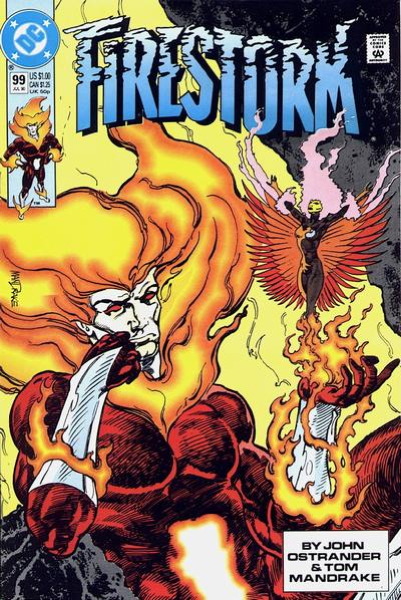
And then after this there were additional revivals/revamps of the character, specifically with new kid Jason taking over the role:
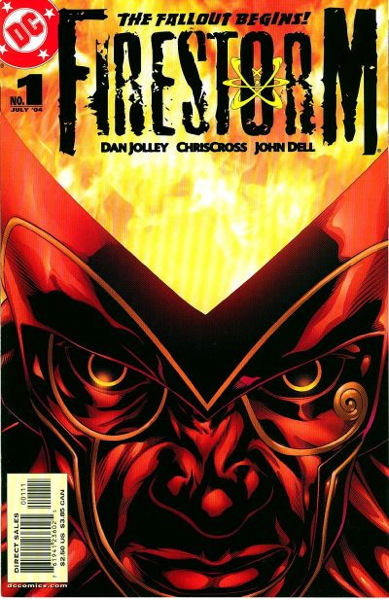
…in a fun series that provided a new take on the premise, while still following up on characters and events from the previous series. Of note: the end of DC’s Brightest Day event included an epilogue that threatened a dire fate for Firestorm that clearly was going to lead into…something, but that (and other set-ups from the end of this series) were cut down a’bornin’ with the advent of the New 52 publishing initiative. That to me was a major clue (along with what appeared to be poor, rushed planning overall) the New 52 was as much a surprise to DC as it was to the rest of us.
Anyway, Jay, I realize a lot of that was more “here’s a history of Firestorm” more than “what I liked about Firestorm,” but all these twists and turns in the character’s timeline always kept me interested. Until the cut-off and relaunch with the New 52, you could drawn a line from those beginnings as a 1970s series canceled early due to the DC Implosion, to all those Brightest Day shenanigans. I enjoyed being able to follow the lives of these characters for so long, and though their original story didn’t end so much as stop, as is often the case in superhero comics, the ride was of course all the fun.
I will say that the reveal of Martin Stein as a bad guy in Doomsday Clock was not my favorite thing. Who knows if DC’s “Infinite Frontier” initiative takes care of that or not. IT BETTER.

Man of Steel #1 in 1986 is generally considered to be Patient Zero for the variant cover marketing strategy in the comics marketplace. You had the standard cover on the left, with a cover layout duplicated by the other five issues in the series. Then on the right you had the fancypants cover with the metallic ink an’ such. Both were available in comic shops, but only the standard cover could be found on newsstands.
I mean, sure, it’s understandable that DC would want to go through the extra effort of slapping a second cover on the first issue of this series. This was, after all, a complete revamping — a “reboot,” if you will, perhaps you’ve heard that term — of their flagship character by a superstar creator. This comic was indeed A Big Deal, and doing somethin’ a little special to make it stand out was certainly warranted.
Now, did fans end up buying both covers? Not all, I’m sure (I myself just got the comic shop-only cover…I liked the design of the standard covers, but I thought Clark’s pants looked weird), but certainly a non-zero percentage of consumers couldn’t decide between one or the other and solved the dilemma by taking one of each home.
This is of course not including the sales to speculators, a market segment that would absolutely explode in the 1990s but certainly existed prior to that. (See also Shazam! #1 and Howard the Duck #1 from the 1970s.) I’ve experienced more than one acquisition of books from investment collections containing stacks of Man of Steel issues. But if I could hazard a guess…I think comic companies began to learn that not just speculators but your regular readership could be convinced to pick up more than one copy of the same book.
Look, some fans were doing that anyway. The “buy one to save, one to read” thought process had been there for years. Whether the idea is “I’ll have a back-up if my reader copy falls apart,” or “I’ll have a mint copy for resale” borne of either a genuine belief in a return on investment, or some kind of self-justification for still buying these things, it doesn’t matter. But those were purchasing decisions, both small scale extra copies here and there and the bulk investment procurement, were made independently of the publisher’s efforts. Sure, DC and Marvel and whoever else can throw “COLLECTOR’S EDITION!” blurbs across the covers but c’mon, no one falls for that any more.
But two covers? With two different images? That’s something a publisher could do to encourage duplicate purchasing. Granted, likely not a lot, but not nuthin’, either. Naturally the burden is on the retailers, particularly in the direct market, to try to determine order numbers on a comic with two different covers. Not just the “how many customers will buy both” question, but the more basic issue of “which cover will generate more demand?” What if one cover is preferred over the other? What if one cover is a complete dud nobody wants, and you’re stuck with that cover while selling out quickly of the other? Surely most customers wouldn’t have that binary a preference…yeah they’d like that one cover, but oh you only have the other, sure that’s fine.
If the variant cover on Man of Steel #1 didn’t help sales a least a little upon release, we probably wouldn’t have seen more of them shortly thereafter. Of course, we did, such as these specific parodies of Man of Steel and its two covers by Boris the Bear and the one-off parody comic Man of Rust.
And DC itself had a big variant cover rollout again in 1989, when they published Legends of the Dark Knight #1, as part of the big movie-inspired Bat-push that year:
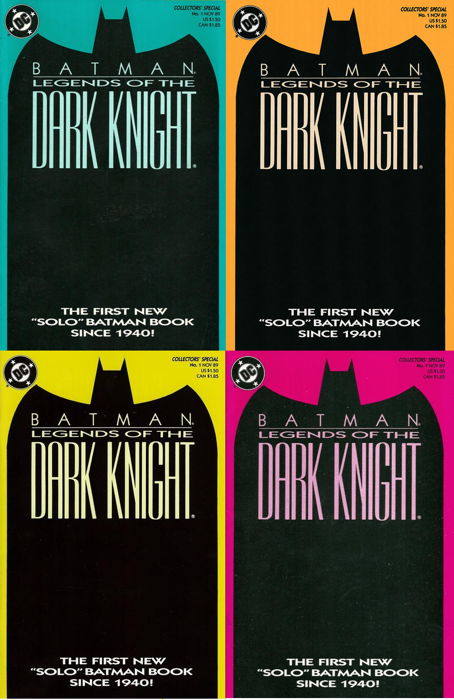
This time it appeared as if DC was testing the limit of what actually “counted” enough as a variant cover to generate multiple-copy purchases by consumers who wouldn’t ordinarily do so. These were just “extra” covers, attached over the comics regular cover, printed with four different colors. Now, I wasn’t involved in the retail end of the comic business when Man of Steel rolled out in ’86, but I was definitely behind the counter in ’89, and I do vaguely recall grumbling from both customers and retailers about this blatant marketing ploy.
Actually printed on the inside of these extra covers was a message from the editor, explaining why the extra covers:
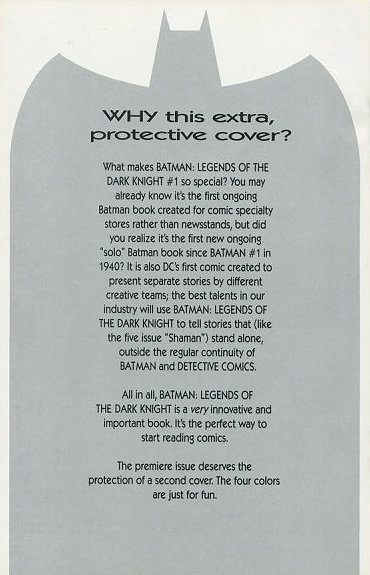
“The four colors are just for fun,” it says, but they’re also for goosing the collectors out there into buy more copies. EDIT: Now as it turned out, and I had forgotten about (but reminded my readers James and BobH), the reasoning behind these covers was that preorders were so high, again this being the time of the Batman movie-inspired craze, that it was feared it would be too many for retailers to sell and the market would be flooded. As such, these multi-colored additional covers were printed and affixed over the regular covers. And the reasoning for this was, clearly, to encourage collectors to buy more than the one copy.
And I promise you, as a fella working the register at a comic book store in 1989, I sold plenty of sets of all four covers gathered off the shelf by members of our clientele. And there have been plenty of these sets spotted in boxes of books brought back to me to sell over the ensuing decades.
If all it takes is just different colors to boost orders and sales, what other minimal perceived value-adds can be given to books to get folks’ wallets out? Maybe just prepacking a comic in a sealed polybag right out of the gate? Or having to buy every version of one issue, each packed with a different trading card, to get a full set? There can’t be any way those ideas would work.
More on variant covers coming next time, informed in part by your great responses to this post from last week. Thanks for reading, pals, and I’ll be back here in a couple of days.
So when I crack open the shipping boxes from my distributor(s), it’s not often that I’m caught off guard by what I find inside. …Okay, wait, scratch that, I am frequently surprised by stuff like getting a single plastic Legion of Super-Heroes ring by itself in a full-sized box, or even this week, when I received 53 extra, unordered copies of a variant for the new Magic: The Gathering comic.
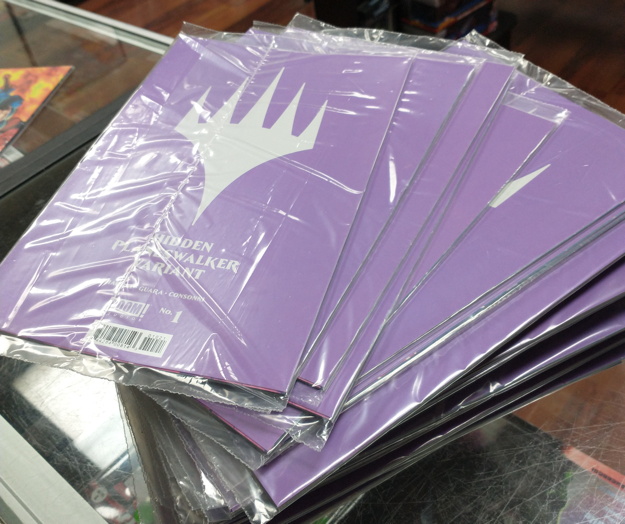
What I mean by “surprised” in this case is a good surprise, as I’d completely forgotten that I ordered copies of this for the shop:
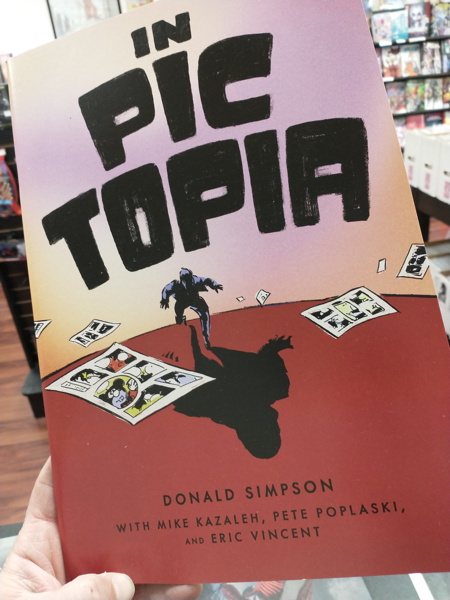
This is a treasury-sized reprint of the classic story from issue #2 of the 1986 Anything Goes anthology. It was a surprise because I 100% forgot I’d ordered it and that it was coming.
The story itself is 13 pages, presented here in full color and looking possibly even more beautiful than it did in its original appearance. The rest of this 24-page publication is mostly text (with some illustrations), addressing the creation of the comic, what Anything Goes was for (raising legal costs for Fantagraphics), talking a bit about the fact The Author’s name isn’t on the cover, that sort of thing.
Now, to be fair, I haven’t read this yet. I mean, the original comic I read plenty of times since its initial publication, as I was one of those guys buying Anything Goes as it came out, and I was in the bag for anything The Author was writing (thanks to his Swamp Thing work, natch). But there are a couple of nice alternate covers for In Pictopia by the story’s primary artist, Don Simpson, in here, which apparently were art commissions or for a planned reprinting that didn’t happen.
I did catch somewhere in here where it said the story was “much anthologized,” which I wondered about. The only place I could come up with off the top of my head is the 1990 Fantagraphics collections Best Comics of the Decade (which I also own), and the Grand Comics Database entry I linked above mentions a 2016 collection. I don’t know of others, but honestly, it wouldn’t surprise me.
A quick Googling around seems to reveal at least some of the backmatter in this book had appeared on Simpsons’ own blog, but that’s fine. It’s nice to have a print copy in hand that I can still read long after the internet is destroyed for the good of humanity.
What’s funny is that I almost missed ordering this…it’s stuck in my head as being titled just “Pictopia,” and that extra preposition was enough to throw me off just a tad. Plus, not seeing The Author’s name in the credits also misled me to a degree…look, when I’m doing my orders, I have tons of different solicitations in the catalog all vying for my attention so sometimes even the most obvious things can take a moment to make it through my occasionally-working eyeballs and into my brain.
And then on top of that, once the hamsters started to turn the wheels in my head a little more quickly and I realized what “In Pictopia” was, not seeing The Author’s name made me think “wait, are they doing new Pictopia stories without him?” Yes, I actually thought that for half a second. Well, okay, maybe a full second. It just didn’t dawn on me that maybe Mr. The Author wanted his name off more than ancillary Watchmen products. (And actual Watchmen and other DC releases, too, but given the existence of Doomsday Clock it’s fair to say the “Keeping The Author Happy” boat has long sailed, at least for the comic books.)
Despite all that, this In Pictopia tabloid is a great looking package, presenting the comic in a good ‘n’ big size, with what looks like pretty dense discussion of it accompanying the story. The comic itself is an allegory for the comics medium and the crushing of the old in favor of the new…so on the nose that it barely counts as an allegory and is more an explicit description of what The Author thought was happening at the time. I suppose the follow-up I briefly imagined would involve a thinly-disguised Raina Telgemeier rushing in to save the day.
It still holds up a good, and melancholy, tale. If you haven’t read it yet, you should. It remains a concise, pointed masterpiece.
Should also note the contributions of Mike Kazaleh, Pete Poplaski and Eric Vincent, so that the guy who doesn’t want his name involved isn’t ironically the person I refer to the most here.
So the other day, on some streaming app or ‘nothing, I watched, for the first time in a very long time, two episodes of the late ’70s/early ’80s sitcom Mork and Mindy, starring Robin Williams and Pam Dawber. I think, actually, this may have been the first time I’d watched full episodes of the show since it originally aired. Oh, I’ve seen bits and pieces and clips and such since then, but watching one from beginning to end? It’d been a while.
But here’s the thing about Mork and Mindy. There was a particular magazine that I bought (or cajoled my parents into buying for me) early in the show’s airing that has stuck in my mind for decades after it was discarded in whatever cleaning incident took its life. You know the phrase “living rent-free in my head?” Well, it was this magazine, doing so for so many years. (I told my girlfriend about the “being stuck in my head” thing, and she responded “poor magazine,” which, well, yeah.)
Not sure why the memory of this specific mag was trapped in my RAM and not shunted away to the tape-drive back-up. The cover remained lodged there, and I could only recall one specific article.
Oh, the mag in questions: Cracked Collectors’ Edition #29 (May 1979):
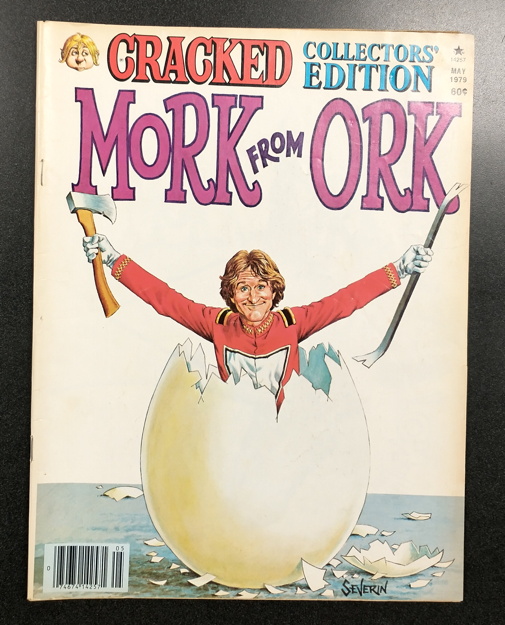
Inspired in part by the recent viewing of the television show, coupled with the fact the mag had been nagging at my mind for so long, I dipping into eBay’s waters and fished one out.
The cover is, of course, by John Severin. A master caricaturist, it seemed he could draw any real person from any angle, still have it look like them, make them “act” on the page, and it never once made you think “look at that photo reference.” Cracked may have been the mag you picked up if there wasn’t a new Mad out yet, but by God Cracked had John Severin and Mad didn’t, so big points in its favor there.
Which isn’t to say Cracked didn’t have other fine cartoonists in their stable, because of course they did. And plenty of hem worked on this very magazine. It’s just…well, where Cracked maybe fell down a bit, especially in this example, is forgetting the “parody/satire” part of the satirical genre of which the mag was supposedly a part.
Admittedly, it’s tricky, particularly with something like Mork and Mindy, a deliberately wild and silly show. Trying to come at it with a parodic or satirical take would require using some form of humorous perspective sufficiently transformative to be seen as a commentary on the source material, versus just as extension of it.
That is this issue of Cracked in a nutshell. It’s not satirical. It feels like an official fan magazine at times, an unauthorized tie-in to the TV show. So much so that I actually checked the copyright section to see if it had been actually commissioned by the folks behind the show. A lot of the humor is simply “here are some Mork-style jokes we’ve written,” such as having a “reader’s” letters page with answers in the Mork-voice:
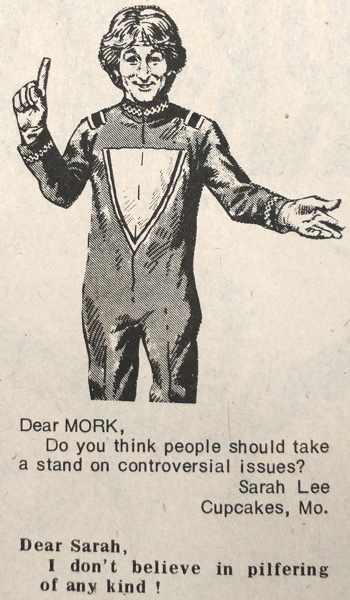
…surrounded with many of Severin’s illos of Mork and the cast to make sure you know who the mag’s about.
And then there’s this article defining words from Mork’s home planet:
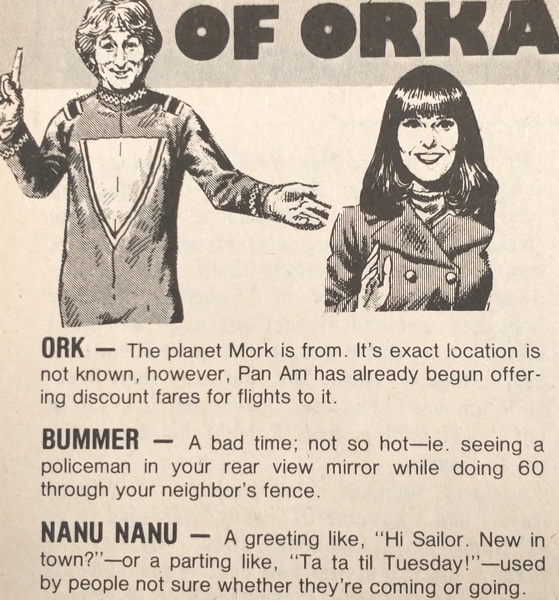
Plus some gag pages about life on the planet Ork, and a look at Mork’s boyhood:
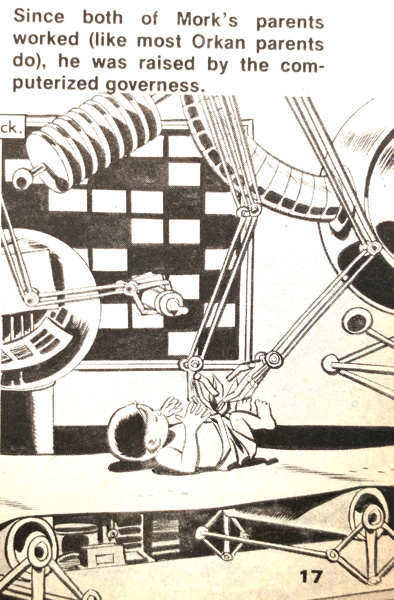
…which is strictly non-canon, of course, given the revelation in season 4 that Mork’s people are born old (in eggs) and age backwards. NON-CANON, DANG IT.
And really, none of this functions as any form of commentary on the show. It’s all either explanatory (like the glossary of terms) or Expanded Universe/fan-fiction-y (like Mork’s childhood). There’s a feature on “What If Other Actors Played Mork” with stills from movies and TV shows giving in-context Mork-style jokes. (Or “jokes” – one of which is a cowboy, just shot, being given the dialogue “that hurts, get me out of here, Orson! “which…what?) I suppose that’s…parody-ish, maybe?
Again, there’s nice art in this…Cracked never skimped on the funny drawings, at least back when I was reading. And that specific article I remembered all these years that I mentioned up front? “…All Seriousness Aside,” a text biography of Robin Williams (with a nice big photo of him accompanying it). Of everything inside the mag, the one that stayed with me was not comics. Go figure. I think part of it is that the title puzzled me, as a sometimes chowderheaded 10-year-old that I was. “‘All Seriousness Aside?’ Shouldn’t that mean that they put all the seriousness away and that this biography should be funny?” …As I said, chowderheaded.
I presume Cracked being recognized as part of the same school of satire as Mad Magazine is what kept any ceases-and-desists away in cases like this, where the “take-off” is barely distinguishable from licensed product. And frankly, Cracked rode that Mork and Mindy train hard. Just like they did Happy Days and the Fonz. And Star Wars. And Diff’rent Strokes. Boy, did they love Diff’rent Strokes. There was lots of Mork content in the regular mag, and there was even a second special like this one featuring all-Mork, all the time.
I don’t know if any of the other Mork articles in other issues were more along the lines of real satire. I know I had this issue as a kid, and I feel like maybe this might have made more of an attempt at poking humorous fun at the concept rather than write for it, y’know?
Mostly I think I was just surprised at how…low effort the humor was. I’d expected it to be more like Mad, but it was basically, I don’t know, Starlog.
At least it’s all nicely drawn. And overall…it’s not so bad if you take it for what it is: an exploitative fad-riding cash-grab, presenting a topic under the guise of satire but not really saying anything about it.
And before you say anything…I just noticed they used the same drawing of Mork in two of the pics posted above. Sigh.
So I was processing a few books I acquired from a collection on Thursday, and one of them was New Teen Titans #36 from 1987:

It has an October cover date, but according to this page it was out late June, so I’d just graduated high school, was about to start college, and was still a year away from entering the world of comics retail in which I am still fully ensnared.
I’d bought a copy of this issue of the rack at the time, most likely from my future place of employment. I’d come somewhat late to the New Teen Titans, the first issue of which I’d bought being around #27 or so of the initial series, where they’re fighting Brother Blood. I continued to read it after that, going into the bins for back issues (again, from my then-future place of employment) and picking up the new ones as they were released. Even rode out the whole “hardcover/softcover” transition was the series was weaned away from newsstand sales and put firmly into the Direct Market of comical-book shops.
What I’m telling you is that I read New Teen Titans for a while. Big fan, thought it was great. Still think it’s great, even if, like mentioned in our discussion of Crisis on Infinite Earths, the art was usually beautiful (primarily by George Perez, but some of the other artists weren’t too shabby either), and the writing was…certainly of its time, but still readable. It was a Fun Book, essential reading if you were a DC fan (just as Uncanny X-Men was required if you were a Marvel fan). (Or hell, if you were just a comics fan, you probably read both.)
But when issue #36 came out…I mean, I bought it, I took it home, I read it. The more I thought about that cover, however, the more I came to believe it was, I don’t know, insulting my intelligence somehow. Like I saw the “IT FINALLY HAPPENS! STARFIRE KILLS” blurb for the somewhat tasteless pandering it was. I just plain didn’t like this cover, that blurb, and it put me off so much that I dropped the comic. (For a while, more on that in a second.)
I’m sure there was more to it than just a dumb cover blurb. While, as I said, many of the artists who came after Perez on the title were perfectly fine and enjoyable, they were usually in service to stories and scripts that just didn’t grab me. I don’t know if it was me, just having read enough Teen Titans for the time being, or if maybe without the magic partnership with Perez, Marv Wolfman’s storytelling was not quite as inspired, making the book no longer as compelling and vital as it once had been.
Ultimately, it was likely a combination of factors that caused me to drop New Teen Titans. It’s that blurb, though, that sticks with me, the marketing straw that broke this collector’s…long box? Sorry, the metaphor got away from me, but regardless, it’s just one example of how attrition occurs on longish-running titles, for on what the surface may be a nitpicky reason that serves as a blanket excuse covering the myriad of other issues involved in the decision.
And what did I say above about coming back? Why, yes, I eventually did…I skipped that whole brouhaha between 37 and 49 and popped back in when Perez returned for the revised origin of Donna Troy beginning in #50:
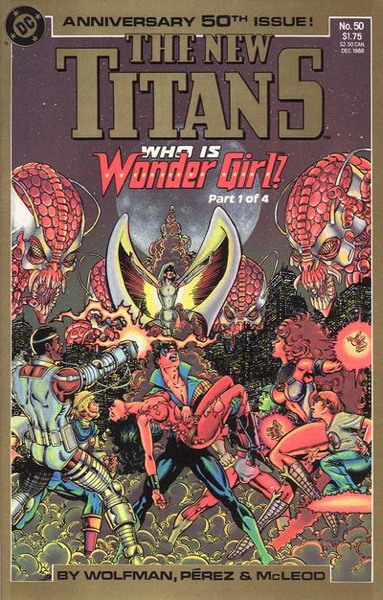
…and looking at this pic reminds me of how the gold ink on this cover never looked shiny and clean, even new off the shelf. Just…”give me your most dingy gold ink, my good man” said DC at the printer, and they were happy to oblige. But cover coloring aside, the story was…fine, a new convoluted revision to the ever-revising Donna Troy origin. As soon as it was over, I was off the book ’til 1990 and the release of issue #71:
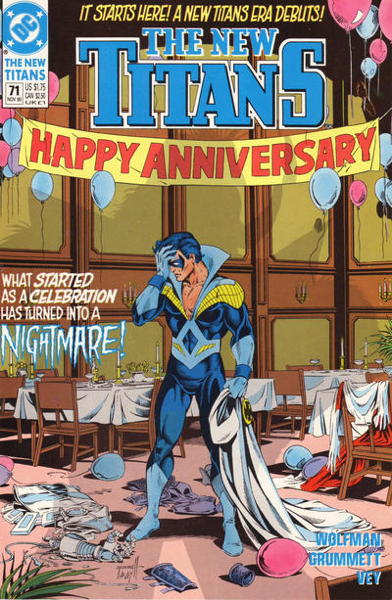
…because I’m a sucker for extree-sized anniversary issues, and also because I do like the Titans and wanted to give it another shot.
And I picked a good time to start up again because hoo boy it felt like Marv Wolfman found his second wind on the title. It was a leaner, more exciting ride, aided and abetted by some of Tom Grummett’s best artwork, and it just kinda steamrolled along for a while. Surprises in each issue, no character felt safe, cliffhangers galore…the book had a manic energy to it that was just carried you along. For a while there New Titans was one of my favorite series.
Eventually everything peaked and the book settled back down to a more normal pace…still good and perfectly enjoyable, and I hung on ’til #100 (another extra-sized anniversary issue) and that, as it turned out, was my Teen Titans saturation point. When the long-awaited graphic novel Games was finally released in…was it really 2011? That late? Anyway, when it came out, as intrigued as I was at reading another Wolfman/Perez comic, and I had the book in my hands, looking at the front and back covers and thinking about it hard, I ended up not delving back into that world.
I did give my Titans run a reread about a decade or so ago, enjoying what would turn out to be a final run through the book before I opened my own shop in 2014 and gave up all my copies to fill back issue stock. It was a Good Comic, fun and exciting and dopey and beautiful and melodramatic and compelling in all the right quantities and I’m glad I read it. Even if I’m occasionally reminded of why I didn’t like it sometimes, as per that cover at the top of the post.
Occasionally I think about getting one of the many reprints of at least the early Wolfman/Perez issues, to have them on nice paper for future perusal (especially since on my last reread I noticed the paper and printing in the original comics having not really aged well). Honestly, though, I don’t know if I’d make the time to go back to read them, particularly at the moment when I’m still catching up on a backlog of comics. But it’s good to know it’s being preserved, and not just forgotten in the dusty back issue bins of comic book stores.
Now the Teen Titans cartoons? Those are great, too, but that perhaps is for another post.
JohnJ has this to say
“There must also be some basic pricing difference between copies still bagged and those removed from bags, just as there would have been with Superman #75 or Spider-Man #1. Is an X-Force #1 even possible to be considered ‘mint’ if it’s out of the bag and card-less? No matter how pristine the book itself might be, would the ‘slabbers’ turn up their noses at it?”
When I price comics, I do indeed take into account opened/missing bags, removed inserts (like trading cards) and stuff like that. There are also those comics with the Mark’s Jewelers ads where even in the price guide their presence, or lack thereof, is factored into pricing. I mean, I guess technically having those inserts removed would be similar to an old comic having “ad page removed, story not affected” dragging down the price, so I can see the logic there. Either the comic is complete as published, or it isn’t. Whether that “completeness” impacts the price, and by how much, is the matter than can be debated.
For something like X-Force #1, where sealed copies are still relatively plentiful, unbagged copies can go for next to nothing. Same for Adventures of Superman which is hard enough to sell complete and presumably mint at anywhere close to its barely-above-cover-price guide listing (or even at a dollar a pop, like I’ve been trying to), much less naked, exposed, trading card-less. In both cases I usually just toss ’em in the bargain bin when I come across them, though sometimes I’ll put a bagless X-Force #1 in the regular bins in case anyone just wants a reader copy for cheap and don’t want to hunt through the random cheapo boxes.
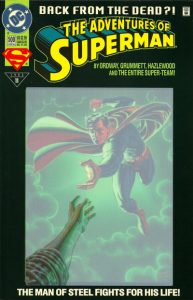 There is a grey area, of course, with the “opened bag” — the Death of Superman issue still sells with an opened bag and most, if not all, of its contents. Not for the full premium, of course, but not bargain basement prices, and there’s still demand for it. Compare to X-Force #1, where the main driving force for collectors right now is whether or not the Deadpool card is included, and whether that card is in “mint,” so sealed copies are preferred.)
There is a grey area, of course, with the “opened bag” — the Death of Superman issue still sells with an opened bag and most, if not all, of its contents. Not for the full premium, of course, but not bargain basement prices, and there’s still demand for it. Compare to X-Force #1, where the main driving force for collectors right now is whether or not the Deadpool card is included, and whether that card is in “mint,” so sealed copies are preferred.)
Now as I recall (haven’t checked of late, because I think this was dumb), the price guide’s stance was that so long as the bag was opened neatly and all contents were intact, it should essentially be priced the same as a sealed copy. Which of course is bananas, as in actual real life customers will pay more for a sealed copy, and less, or nothing at all, for an unsealed one.
And then there’s 1990’s Spider-Man #1, where you could get the green cover, the black ‘n’ silver cover, or either of those covers sealed in a special polybag. The polybag editions were just polybagged…no inserts included. The polybag was the gimmick, and a gimmick so dumb that my former boss swore he’d never stock that particular version as a back issue in his shop. So anyway, having the bag in this case damaged or removed made those variants sort of pointless, and why would you want to open them anyway? To read this comic? Have you read it? C’mon.
I mean, in the old days, unbagged copies of the bagged Spider-Man would have been pointless, except now, as the need for collectible comics intensifies in the face of declining supply, they are now selling for higher prices. Specifically as “unpriced variants,” since these bagged editions had their retail prices printed on the bags themselves, and left off the actual covers. A speedy search of the eBays turned up a “no price” black variant at $16.99.
I figured “McFarlane’s Spider-Man is a hot comic, so I guess demand is up for any copies of this” but in fairness I looked up Adventures of Superman #500, which earlier I asserted debagged copies of the white-bag variant are essentially worthless. Well, I still think they are, but that’s not stopping folks from selling slabbed, graded copies for $100 plus. And “raw” copies, too, for the usual $1 to $3. Amazing.
Online pricing doesn’t necessarily reflect real world pricing on collectibles, of course. I’ve sold stuff online for premium prices that would get me laughed out of town if I tried them in the store. And I’ve tried to move things online for any price that ended up selling more quickly, and more dearly, in the ol’ brick and mortar. So [throws price guide up in the air] who knows, man.
On a related note, I wrote (egads, nearly nine years ago) about Marvel Comics and their digital code stickers, and how their removal would or would not affect pricing. Oddly, it hasn’t really come up too often, aside from one collection of books I took in a couple of years ago. My rule of thumb, as stated above, remains “is this book as it was originally published?” If it’s missing the sticker covering the code, then no, it’s incomplete. A very nit-picking incomplete, but nonetheless, by technical definition, it is as such. Now it doesn’t affect pricing that much for these mostly recent books, but what if in a few decades, whatever today’s equivalent of Incredible Hulk #181 (almost certainly that first evergreen-hot appearance of the Gold Lantern) is missing a sticker? Will its going market price of 2000 Space-Credits drop down to a measly 1200 Space-Credits? How’s someone supposed to send their clone-child to Ceti Alpha V Academy on that little amount of money? Or will it be taken in stride, like the Guide’s instance that arrival dates on covers for comics of a certain age shouldn’t affect the grade? I guess time will tell. Time travelers, come back and let me know.
• • •
In other news, after a long hiatus, mostly enforced by ongoing eyeball issues, I am attempting to return to doing my coverage of Swamp Thing issue-by-issue as
Patreon-exclusive content. Probably at a less-frequent pace than I was attempting, but I plan on filling the gaps with brief audio content (the very brief first installment of which has already been posted, not really saying much more than what’s already said here). So, if you want to hear my warbly voice barely make it through a sentence without stumbling, now’s your chance! (This may be practice for a full-fledged actual podcast at some point in the near-ish future.)
When I first started the Swamp-Thing-a-Thon, my intention was to post it exclusively for Patreonites, then release it here on ProgRuin several months later. Well, I never did that last part, so I’ll try to get another one posted this weekend. In the meantime, here’s the very first installment I posted about House of Secrets #92.
Thanks for reading, pals, and I’ll catch you on Friday.
« Older Entries
Newer Entries »
























 There is a grey area, of course, with the “opened bag” — the Death of Superman issue still sells with an opened bag and most, if not all, of its contents. Not for the full premium, of course, but not bargain basement prices, and there’s still demand for it. Compare to X-Force #1, where the main driving force for collectors right now is whether or not the Deadpool card is included, and whether that card is in “mint,” so sealed copies are preferred.)
There is a grey area, of course, with the “opened bag” — the Death of Superman issue still sells with an opened bag and most, if not all, of its contents. Not for the full premium, of course, but not bargain basement prices, and there’s still demand for it. Compare to X-Force #1, where the main driving force for collectors right now is whether or not the Deadpool card is included, and whether that card is in “mint,” so sealed copies are preferred.) 





